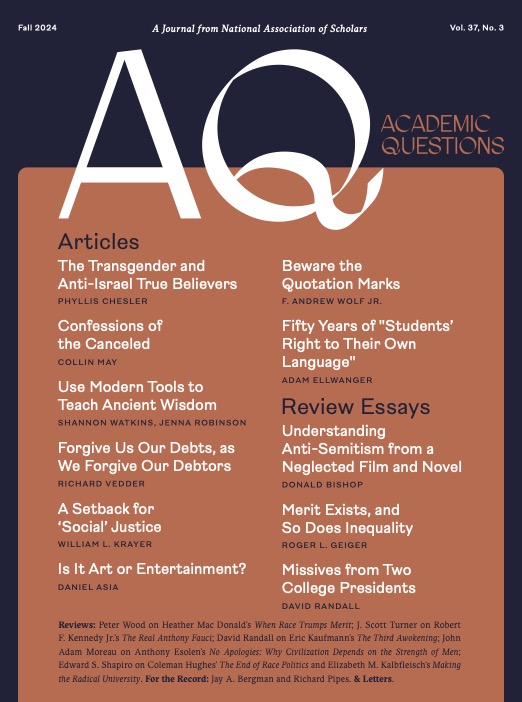The Third Awokening: A 12-Point Plan for Rolling Back Progressive Extremism, Eric Kaufmann, Bombardier Book, 2024, pp. xxii + 395, $19.99 paperback.
Sociologist Eric Kaufmann’s Third Awokening is a curiously disjointed book. Kaufman is an old-school liberal, but he urges support of conservatives as the strongest available political force. He diagnoses the cause of the Third Awokening not as Cultural Marxist cadres marching through the institutions, as does Chris Rufo, or the downstream results of civil rights law, as does Richard Hanania, but, following Shelby Steele in White Guilt, as rooted in emotional, liberal, intellectually incoherent (and especially female) sentiment—and then offers as the cure middle-of-the-road policy prescriptions. Third Awokening has many virtues, but it is neither fish nor fowl, and that weakens its effectiveness as a guide to de-wokening America and the world.
Kaufmann’s largest argument is that the motor of wokeness is an emotional transformation that took place in the 1960s in America, and in the 1970s in Britain: “The Third Awokening revolves around the left-liberal anti-racism taboo of the mid-1960s. Like the big bang, this was a cosmic event; its logic has been progressively expanding, defining our social universe.” (xii) The old emotional attachments to liberty and nation faded and were replaced (especially among women) by an egalitarian care/empathy reflex directed first toward blacks, then toward all other identity groups that could piggy-back onto that emotional reflex. The care/empathy reflex made racism taboo—and, by quick extension, any argument that any group inequality was not the result of racism.
Kaufmann, by a sociologist’s tools of charts and potted history, traces the extension of woke ideology from the universities to a remarkably large swathe of government, law, and civil society, with particular appeal to overlapping groups of women, homosexuals, and the mentally ill (246-63). Its effects are dire: “cultural socialism is both illiberal and deculturating.” (119) Wokeness now offends old-school liberals because it is illiberal (abrogation of free speech and due process, cancel culture, self-censorship); it likewise offends conservatives because it seeks to eradicate national cohesion and identity. It imposes “asymmetric political bias” (149), since discriminating leftists now dominate most elites. It provokes ever greater populism, since the polite establishment is no longer willing to espouse large swathes of policies. It creates political dysfunction by rendering those same policies unspeakable, because they violate woke taboos.
Kaufmann identifies this as “cultural socialist,” (6), but he emphasizes its continuities with liberalism rather than with Marxism, since its animating taboo ultimately has liberal origins. Kaufmann argues that woke is much stronger than its opponents realize, precisely because it is emotional and liberal rather than intellectual, legal, institutional, or Marxist, and liberal is part of the long American mainstream. Woke, since liberal, also operates by bottom-up, peer-to-peer, genuinely popular repression. Woke, since based on emotional reflex, cannot be defeated simply by argument: as Jonathan Swift put it, “Reasoning will never make a Man correct an ill Opinion, which by Reasoning he never acquired.” Woke, since based on emotion, is driven by the most personal of bigotries; unwillingness to date a conservative/Republican/Brexiteer is by far the most powerful predictor of political illiberalism (153-66). And wokeness will only increase in power for at least the next generation: “As they [the woke youth] become the median employee in elite institutions and attain positions of power, they are likely to upend the country’s classical liberal and patriotic creed. The senior liberals who are behind the modest anti-woke correction in the mainstream media will have left the scene as part of the inevitable generational turnover of institutional leadership (xiii).”
An appealing aspect of The Third Awokening is Kaufmann’s emphasis on education reform policy, both at the K-12 and the undergraduate level. The university, after all, was the crucial incubator of wokeness, and remains a central mode of infecting the broader culture (87-93). Moreover, “Public school education is the most important lever for changing the way future generations of voters think, thus classical liberals and conservatives must make this their top priority” (366). Kaufmann very much emphasizes that government must intervene to protect academic freedom, and indeed to dry up woke indoctrination before it forms emotional attitudes in our children.
This indoctrination is having its intended effect. In the U.S., those who are taught Critical Social Justice (CSJ) concepts are up to thirty-five points more likely to affirm them. This also shapes students’ party identification and political beliefs. “Thus, I find that American young people exposed to no CSJ concepts break 27–20 for the Republicans over the Democrats (the rest being Independent), while those taught the maximum of eight CSJ concepts lean a whopping 53–7 toward the Democrats” (244).
Conservatives, practically, must act, and they must not be inhibited by inappropriate libertarian scruples: “Conservative governments need to purge woke politicization from the classroom, making this an overriding goal” (xx-xxi). Kaufmann, in other words, is endorsing precisely what the NAS does, and what the author in particular does in his work for the Civics Alliance. When the author of the book you review says Keep on truckin’, what can one say but Thank you, we will!
Some part of Kaufmann’s policy prescriptions is based upon his diagnosis of the emotional and incoherent nature of wokeness. Many woke, in other words, are in favor of anti-racism, diversity, and other woke buzzwords, but oppose the coercive policies that are their logical corollaries: in one notable thought experiment, “there is a middle ground of some 30 to 60 percent where progressives are torn between their cultural socialist and liberal values” (145). Kaufmann’s policy prescriptions are based on the intellectual incoherence of the woke: that one can somehow eliminate the worst policies carried out in the name of wokeness, without triggering the emotional reactions of the woke, since they don’t realize how dictatorial is the policy their sentiments logically entail.
Kaufmann’s polemic against conservatives who diagnose wokeness as Cultural Marxism underplays the importance of articulate cadres. Even if wokeness is fundamentally emotional, it matters that it has been given a Cultural Marxist articulation. Kaufmann himself acknowledges that, “Revolutionary Marxists were important in the production of new cultural socialist ideas even if left-liberals did the heavy lifting in the institutions” (54). Yet Kaufmann’s emphasis on emotional liberalism is a helpful reminder that the Cultural Marxism diagnosis facilitates false optimism. If wokeness is rooted in Cultural Marxism, it will be relatively easy to uproot; if it is rooted in emotional liberalism, the task of uprooting it will be much more difficult. Kaufmann’s diagnosis is sobering—and I think he is correct that our task is greater than the diagnosis of Cultural Marxism implies. We still should work to root out Cultural Marxist policies and indoctrination, but we should not believe that will be sufficient.
Kaufmann’s polemic against the conservatives who diagnose wokeness as Civil Rights law underplays the importance that diagnosis ascribes to reforming our laws. It does matter that civil rights law, as currently interpreted, gets businesses to prohibit non-woke speech for fear of being sued to death. The “educative” function of the law, and the workplace environment, are not trivial. Kauffman’s own emphasis on the importance of institutions and effective monopolies (22-28) aligns with a Hananian focus on civil rights law. Perhaps the emotional reaction preceded the law, but the law skews government, law, and business to enforce that emotional reaction. Reforming Civil Rights law may not be enough, but it is also necessary.
Kaufmann convinces the reader that more should be done—but his ultimate solution is completely unsatisfactory. On the one hand, there is an odd Machiavellianism that does not quite convince: we old school liberals should support conservatives, because there are more of them and they are the only effective opposition to the woke; but conservatives should support old-school liberal policy measures, because—it is not entirely clear why. Certainly old-school liberals need conservatives: “it is only when culture war questions decide elections that the moderate liberals will gain leverage against the radicals to support a post-woke politics of institutional reform” (xix). The necessity for conservatives to follow old-school liberal policy preferences is less obvious. Kaufmann calls for “A Christian Coalition for Secular Culture” (349) —but why would Christians bother? Kauffman does not make the case for such a strategy intellectually or practically. What precisely do old-school liberals add to conservative opposition to wokeness? Why are they needed?
Kaufmann’s prescription also is unsatisfactory because it does not address the challenge he poses: how do we shift the emotional attachments that formed wokeism? If woke “is more mythos than logos” (4), if wokeism is not a reasoned ideology, it cannot be addressed by policy fixes such as Kaufmann recommends. Moreover, to say the anti-racism taboo must become a proportionate norm is bound to be ineffective—not least because it preemptively concedes the legitimacy of wokeism. “A cultural liberal perspective based on individual rights and equal treatment within a utility-optimizing system urges us to reach an optimum outcome across all groups” (8) does not sing. Believe what you believe less strongly can never compete with believe firmly in an alternate ideal. Wokeism must be challenged and replaced by recreating the emotional attachment to America and the republic. But Kaufmann is silent about how to change emotions, save implicitly by his focus on K-12 education.
Focus on K-12 education is too imprecise a solution. Kaufmann’s diagnosis points to education policy that focuses on instilling popular affection and devotion to America and to Americans. It is all well and good to teach knowledge of the Constitution, and the facts of the slave trade, and how a free market works, and the existence of Christopher Columbus, but the point of public education must be to instill love of America. All the throat-clearing about warts and all, teach our sins as well as our virtues—that’s secondary. The first lesson, the most important lesson, if necessary the only lesson, is to hold our country dear. Education reformers seeking to reform our public schools, our universities, and our education schools should know that teaching patriotic affection is what they absolutely must achieve.
Kaufmann’s diagnosis also points to some larger guidelines for political reform to save America from wokeness. This project cannot be simply to restore the Old Regime: that collapsed not least because Americans lost their emotional roots to what we had. We must engage in a renovation like that of the Bhakti in Hinduism, that of Hasidism in Judaism, that of the Catholic Reformation in the Catholic tradition, and emphasize the popular devotion, the mystic adoration, the emotional cults of saints and sants and tzadiks who incarnate American virtues. A cadre of Straussian Jesuits is not enough; we need cults of Trump and Glenn Beck and Joe Rogan, we need St. Teresas to wed doctrine to ecstasy, we need pilgrimages to Częstochowa, we need Berninis to move the passions with their art; we need to teach patriotic affection as catechism.
The cults of Trump, Beck, and Rogan, of course, are more those of men than of women. Kaufmann mentions more than once that wokeism is disproportionately female, but he also provides no particular prescription for women’s attachment to wokeism. Implicitly, he calls for holding on to a bare majority of the country for anti-woke policies, and simply overriding the (emotional) preferences of elite American women for illiberal wokeism. If this is truly the best available policy, the American Counter Reformation will always rest on shaky foundations. We need, presumably, to foster emotive cults that appeal particularly to women—devotions to Schlaflian Oprah Winfreys, the female counterparts to the cults of Trump and Beck and Rogan. If such cults are powerful enough, they will even convince young women to start being willing to date conservatives—which, if we believe Kaufmann, is the fulcrum of victory.
I don’t know how creating such cults can be done. But nothing less, if we believe Kaufmann, will secure our country from the woke onslaught.
David Randall is director of research at the National Association of Scholars, 13 W. 36th St., 4th Floor, New York, NY 10018; [email protected]. His most recent books are The Concept of Conversation: From Cicero’s Sermo to the Grand Siècle’s Conversation (2018) and The Conversational Enlightenment: The Reconception of Rhetoric in Eighteenth-Century Thought (2019). Randall’s review essay “Missives from Two College Presidents” appears elsewhere in this issue of AQ.
Photo Rawpixel.com on Adobe Stock














